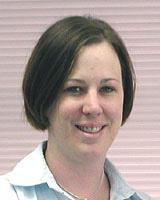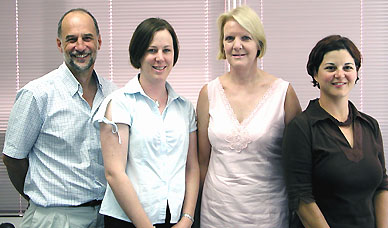Introduction
In response to continued difficulties in recruiting medical professionals to rural areas of Australia, the Dept of Health and Ageing (DoHA) has funded programs to facilitate the exposure of medical students to rural practice and lifestyle. Previous research has indicated that early career rural exposure increases the propensity for rural practice later in life1.
The Rural Undergraduate Support and Coordination (RUSC) program was the first initiative to target recruitment of medical students from rural areas and to increase the rural content in the medical curriculum. The RUSC program has expected all students to spend 8 weeks in a rural area during their course. Subsequently, the Commonwealth government created the University Department of Rural Health (UDRH) program in 1996 for medical, nursing and allied health students and, later, the specifically medical student Rural Clinical School (RCS) program in 20002. This funding stream requires 25% of medical students to undertake at least a year of their clinical training in a rural area.
The University of Adelaide (UA) medical school has an integrated curriculum across all 6 years of the undergraduate program, with predominantly clinical programs in years 4-63. The Spencer Gulf Rural Health School (SGRHS) was created by the UA and The University of South Australia to administer the rural undergraduate health professional programs: RUSC, RCS and UDRH. The programs are able to complement one another and the RUSC programs in particular, conducted early in the medical course, provide a recruitment strategy for the RCS program that requires much greater commitment by the students.
This article describes the development of a RUSC funded first and second year medicine Rural Week (RW) program, presents data evaluating its ability to meet its aims and objectives, and the perspectives of various stakeholders. It concludes with a discussion of the importance of the RW program at UA.
Program description
The reasons for developing a RW program were to:
- expose students to rural 'learning' sites and demonstrate that SGRHS was a valid option for clinical rotations later in their course
- provide rural context by introducing students to 'living' in the Spencer Gulf and initiate discussion of the lifestyle of a rural career4
- maximise the limited opportunities in the medical course to get students into the country
- achieve the RUSC funding targets required by DoHA.
Importantly reasons 1 and 2 form our recruitment strategy for RCS clinical rotations and the potential future rural workforce. Specific detail of the aims of individual rural weeks for first and second year students are contained in Figure 1.
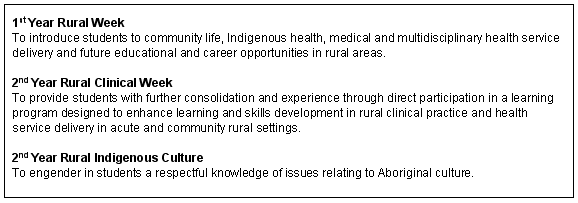
Figure 1: Aims of the rural weeks program.
Objectives
First year Rural Week: During first year RW students are introduced to rural lifestyle, rural health issues, Indigenous cultural awareness, multidisciplinary health care and future rural educational options available in SGRHS. Learning about Indigenous culture and health occurs throughout the 6 years of the medical course at UA. It is introduced in the one-day cultural awareness workshop delivered by Indigenous staff members in the first year RW. The workshop presents information about cultural awareness for health professionals, which is pitched appropriately for first year students' level of understanding.
Students are away from Monday to Friday in a rural location accompanied by an academic staff member from the UA. All of the sites visited (Port Augusta, Port Pirie, Whyalla and Minlaton), are within the Spencer Gulf region.
Second year Rural Week: In second year, students have the option of a Rural Clinical Week or Rural Indigenous Culture Week. Rural Clinical Week involves shadowing a rural GP doing their normal day's work. The students present a case they have seen to the rest of the group and the accompanying academic late in the afternoon. The whole group then discusses the bio-medical science and psychosocial aspects of the cases. This reinforces the Problem Based Learning style of their curriculum but is based on authentic cases they have seen first hand.
Rural Indigenous Culture Week focuses on learning about Aboriginal culture in context from Aboriginal people and the availability and models of delivery of health care in Aboriginal Community Controlled Health Organisations (ACCHO). The students meet and interact with Aboriginal people in Aboriginal controlled community settings, visit Adnyamathanha sacred sites, hear songs and Dreaming stories, have their faces painted with ochre, hear of the local effects of European colonisation in the Flinders Ranges, and have an introduction to local bush food, traditional medicine and the health status of the community.
Methods
Evaluation
At the conclusion of each RW, an evaluation and feedback session is conducted. Paper based Student Evaluation of Learning and Teaching (SELT) instruments have been developed by the Evaluation Program staff of the SGRHS. Questionnaires are voluntary, anonymous, students are able to withdraw at any stage and the questionnaires are self-administered and returned by students. Students are fully informed of the purposes to which their data may be directed (including reports, conferences and publication), as well as the fact that neither completion nor non-completion will impact on their learning or assessment outcomes. As such the university considers these SELT questionnaires as quality assurance and a necessary educational activity and does not require Human Research Ethics Committee approval.
The overriding RW aims and objectives are evaluated, as well as the quality of each specific site. An analysis of this is described in this article. Students also complete a 'Student Attitudes to Working and Living in Rural Areas' questionnaire to evaluate the impact of RW on intention to volunteer for future RCS rotations or postgraduate rural work opportunities5. Analysis of attitudes will be reported in a subsequent article.
Results
The evaluation data collected has been analysed and is reported here under the headings:
- students (quality)
- preceptors (quality and impact considerations)
- university staff (academics and administrative staff)
- community members.
Students
Quality of First Year rural week: In 2003 and 2004, three hundred first-year students participated in structured RW experiences in Minlaton, Port Augusta, Port Pirie, and Whyalla with 292 of 300 students (97.3%) completing valid evaluations.
Students provided evaluation evidence that the programs supported the aims of RW in 2003 and 2004 (Table 1). An innovation in 2004 was introduced to link First Year RW more closely with the Medical Personal and Professional Development (MPPD) component of the curriculum: students conducted patient interviews in nursing homes and prepared and presented case studies. This was well received with 84/127 (66%) of students agreeing that the 'MPPD interview increased my understanding of rural life' and 94/136 (69%) of students agreeing that 'the opportunity to prepare and present a case linked rural week learning with my first year curriculum'.
Table 1: Students' evaluations of key aspects of First Year Rural Weeks 2003-2004. Seven point Likert scale used, where 1 = strongly disagree, and 7 = strongly agree.
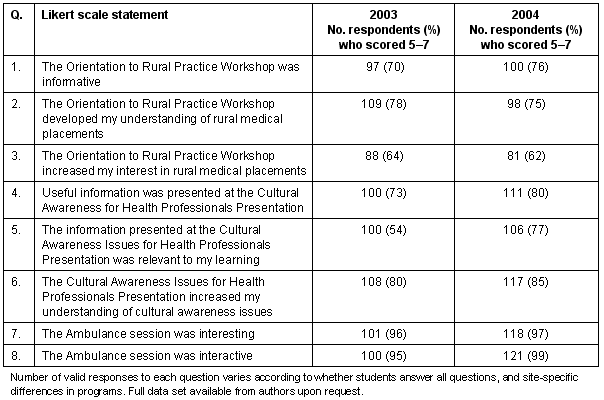
SGRHS academic staff were generally satisfied with the positive nature of these student evaluations. They responded to student concerns by changing aspects of the program, and in the second year they felt they had increased their expertise in running the program. Overall, the First Year student evaluations revealed that students generally valued the RW experiences highly and often surprised themselves with their interest in a hitherto unfamiliar area.
Quality of Clinical Rural Week 2: In 2003 and 2004 one hundred and nineteen Second Year Australian-origin medical students participated in structured Rural Clinical Week 2 experiences in Clare, Kadina, Whyalla and Minlaton, with 117 of 119 students (98.3%) completing valid evaluations.
The evaluations revealed that students most enjoyed the clinical shadowing and that they were welcomed by the practices and involved by the healthcare professional (Table 2).
Table 2: Students' evaluations of key aspects of Second Year Clinical Focus Rural Weeks 2003 - 2004. Seven point Likert scale used, where 1 = strongly disagree and 7 = strongly agree
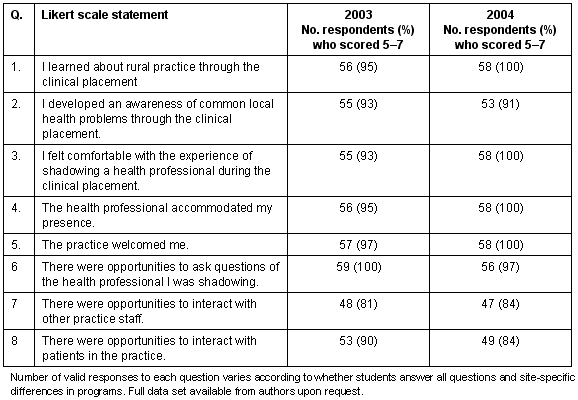
Quality of Indigenous Culture Rural Week 2: In 2003 and 2004, seventy-eight second-year students participated in a Rural Indigenous Culture program at Iga Warta (48 students) and Spear Creek (30 students) (Table 3). Iga Warta is an Indigenous cultural tourism venture, hosted by the Coulthard family on their traditional Adnyamathanha land, in the northern Flinders Ranges. Spear Creek campsite is readily accessible to a range of Indigenous cultural opportunities in the Port Augusta region. One hundred percent of students responded to evaluations in 2003 and 2004 (Table 3). Students report learning about Aboriginal culture from talking to Aboriginal people. However one field trip was marred by a significant misunderstanding between a student and an Indigenous person and led to many students feeling 'uncomfortable' (question 3, in 2004) This required intervention by Indigenous staff and academics at the time, and a group debriefing with most of the students afterwards. Subsequently, senior SGRHS academic and Indigenous staff visited the site, reviewed and tightened protocols for student visits and ensured conformity with university duty of care responsibilities.
Table 3: Students' evaluations of key aspects of Second Year Indigenous Cultural Awareness Rural Weeks 2003 - 2004. Seven point Likert scale used, where 1 = strongly disagree and 7 = strongly agree
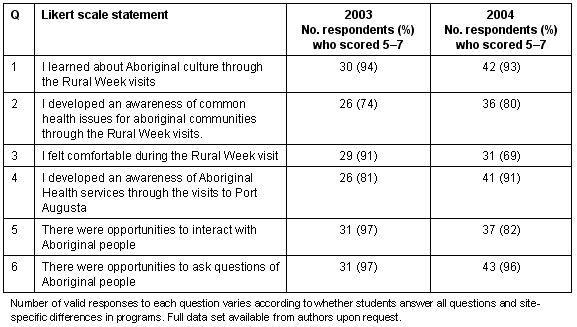
Preceptors
Quality: In April 2003 SGRHS surveyed clinical preceptors who supervised students during RW and for longer placements and received responses from 20 of 25 preceptors (80%). In December 2004, SGRHS surveyed all preceptors who supervised medical, allied health and nursing students. One hundred and forty-five valid responses were received (58% response rate) but, of these, we report here only the 70 responses (48%) returned by medical practitioners.
Medical preceptors reported that they enjoyed the teaching/preceptor role with 64/69 respondents (93%) scoring 4, or 5 on a 5 point Likert scale (where 1 = strongly disagree and 5 = strongly agree). Sixty-one of 67 respondents (91%) reported that they valued their contribution to the growth in student's knowledge and skills role, and 60 of 68 respondents (88%) believed that 'Teaching allows me to promote rural health as a career option'.
Fifty-two of 67 respondents (78%) of medical preceptors believed that 'Being a preceptor enhances my desire to keep up with recent health developments/literature' but rather less, 30 of 68 respondents (44%), nominated their agreement that 'Teaching allows me to have increased contact with the academic faculty'.
Impact: The SGRHS has been aware for some time of the need to develop a model for preceptorship that is sustainable6. Preliminary analysis of preceptors' placement experiences 2003-2004 revealed that the sustainability of preceptors for the clinical aspect of the RW program relates largely to the relationship between preceptoring and the impact on their practice7. In 2003, 12 of 15 medical preceptors (80%) agreed or strongly agreed, 'the placement was an overall positive experience for the practice'. In the 2004 survey of all health professional preceptors in the SGRHS region, 127 of 140 respondents (91%) agreed or strongly agreed to the proposition that 'the placement was an overall positive experience for the practice or department involved', and of the responses originating from medical profession, 59 of 65 respondents (91%) agreed or strongly agreed. Similar proportions of all respondents, regardless of allied health, nursing, medical or 'other' professional stream, report a positive impact of students on their practice/department. This positive acclamation augurs well for the overall future of preceptoring within SGRHS and RW.
University staff
Academics: Reflection by academics involved in the RW program has revealed that successful delivery requires these consistent features across all sites:
- RW are demanding of energy and time, especially when the same site hosts consecutive RW 1 and 2
- working with students, community members and local clinicians effectively during RW relies heavily on the goodwill of academic staff accompanying the students
- the resources and infrastructure within the rural sites are very suitable for RW teaching. The staff and infrastructure set in place by the Rural Clinical School program complements this RUSC program RW delivery
- students begin to engage with the program from the outset, primarily due to the interactive nature of the program. For most students this is their deepest exposure to clinical practice so far
- for many students, this is their first foray into a rural setting. Providing the rural context is the best way to achieve the aims despite the heavy demands on the academic supervisor for the week
- the introduction of summative assessment of RW created more student engagement in the program because they then perceived it as part of their course and not something additional
Administration: In the early stages of RW the administrative support was not 'dedicated' to the RW program, thereby increasing the workload at times on the academic staff, particularly the staff located within the sites. Now that there is a dedicated 'RW team' that is involved in the administrative organisation of the program, this support is valuable to the smooth running of the program because the logistics of getting 140 students to a rural site multiple times during the year is a large organisational task. Administrative support includes organisation of accommodation, transport, meals (in some sites), as well as organisation of information for students and academic staff. Administrative staff feedback their concerns through evaluation and administrative staff team meetings.
Community members
While detailed community evaluation on the impact and potential of RUSC and RCS funded programs is earmarked for 2005 in the SGRHS, students and preceptors have had opportunities to comment on the impact of RW students in the community. Students have reported good opportunities to interact with practice staff and patients (Table 2), and preceptors have reported in qualitative comments that they liked seeing students who were eager to learn, and they liked seeing student's rapport with patients, and that they liked receiving the positive affirmation of their patients regarding students' presence. Students have consistently reported that they feel welcomed by the practice (which includes staff and patients) (Table 2) and their strongest affirmation in evaluation from first year RW students is normally reserved for the ambulance sessions when they meet and interact with community-based volunteer ambulance service members (Table 1). Students on Indigenous Cultural programs also report good opportunities to meet and converse with Aboriginal people (Table 3) in appropriate healthcare and community settings.
Discussion
A 'rural week' program has been developed by the SGRHS and now all Australian-origin medical students spend 1 week in rural South Australia in both first and second years. First year students are introduced to rural demography, to Indigenous culture, to multidisciplinary models of care and conduct a professional interview with a nursing home patient. Second year students choose to learn about Indigenous culture in a remote community or to immerse themselves in the clinical work of rural general practice.
The first two full years of evaluating the RW programs revealed that the aims of rural weeks were achieved. Almost 2/3 of first year students reported an increase in their interest in rural placements, with associated increased awareness of the relevance of Indigenous culture together with their appreciation of the clinical aspects of interviewing patients and interacting with ambulance officers.
In the second year clinical program, both students and doctors have enjoyed the interaction, and students have returned to Adelaide with a better understanding of rural practice. The impact on practices of regular visits by large numbers of students is not to be underestimated. Thorough preparation of students and sites can prevent problems arising, as does the establishment of an ongoing stable relationships between the university and the rural practices and communities. Very productive relationships have developed in towns where the university has had a presence for years (eg Minlaton) or where the same academic regularly visits with each group of students (eg Clare).
Second year students who choose the Indigenous culture field trip understandably reported greater understanding of Indigenous culture than of health issues. Their reported interaction with Indigenous people includes local providers of the cultural teaching and SGRHS Indigenous staff who conduct the program. The misunderstanding that led to students feeling uncomfortable has reinforced our obligation to have students well prepared, for staff to be vigilant, to have staff of both genders present and to avoid the temptation to allow 'alcohol around the campfire'. The intensity and authenticity of learning that occurs when students visit a remote Indigenous community depends on the university ensuring that students are safe at all times. These issues have also been acknowledged in the mass media with the airing of the ABC documentary 'Crossing the line'8.
Frequently medical students are impatient to see the serious ill health of Aboriginal patients. It is essential they first have some understanding of Indigenous culture before attempting to interact with Indigenous patients9,10. Options for Indigenous clinical placements in ACCHOs exist in years 4, 5 and 6.
The sustainability of the RW program depends on the goodwill of the communities. Both professionals and community volunteers (eg ambulance staff) give their time generously and repeatedly because of the positive impact that they perceive they have on students, and the potential for these students to become the future rural workforce. The feedback SGRHS provides to communities reinforces the value of what they give. The number of medical students who are in rural communities has increased enormously from a decade ago when the only funded placements were the beginnings of the RUSC program and the 2 week placements of the John Flynn scholarships. Similarly, the academic and program staff of SGRHS find rural week a demanding 24/7 task. Thorough protocols for preparation have now been established but issues still arise when students would rather be back in the city. Some student groups see RW as a trip away with friends and make more noise, get less sleep or drink more alcohol than their supervising academic would wish.
The RW program fulfills the RUSC requirement of getting all students into a rural setting. The costs of travel, accommodation and some staff costs are borne by the UA RUSC budget. RCS academic and general staff also participate in preparation and accompanying students on field trips. The Department of Health and Ageing now expects this level of integration of the RUSC &RCS programs and this has occurred at UA by one senior academic having management responsibility of both budgets for the last 3 years. Cost efficiencies contribute to the sustainability of the RW program. This is crucial in an education program that seeks to be the first step in redressing the health workforce shortage of rural Australia.
Strategically, the RW program has been designed to reassure students about the quality of living and learning in the Spencer Gulf region. The UA RCS program is firmly based on students choosing to enroll in the RCS options and these RUSC rural weeks were planned to induce students to choose longer rural placements (4th and 5th year at the UA). Preliminary evaluation of the 'Students Attitude to Working and Living in Rural Areas' questionnaire suggest that this is occurring. The critical test of this strategy will occur as students move through successive years of their course and have the choice of entering the RCS program.
References
1. Laven G, Wilkinson D. Rural doctors and rural backgrounds: how strong is the evidence? A systematic review. Australian Journal of Rural Health 2003; 11: 277-284.
2. Department of Health and Ageing. Workforce Education and Training; Rural Clinical Schools. (Online) 2002. Available: http://www.health.gov.au/internet/wcms/Publishing.nsf/Content/health-workforce-education-clinical.htm (Accessed 27 March 2005).
3. Medical Education Unit. Medical education: meeting the challenges. Adelaide: The University of Adelaide, 2002.
4. Bourke L, Sheridan C, Russell U, Jones G, DeWitt D, Liaw S. Developing a conceptual understanding of rural health practice. Australian Journal of Rural Health 2004; 12: 181-186.
5. Adams M, Dollard J, Hollins J, Petkov J. Development of a questionnaire measuring student attitudes to working and living in rural areas. Rural and Remote Health 5: 327. (Online) 2005; Available: http://rrh.org.au (Accessed 17 August 2005).
6. Wilkinson D, Symon B, Newbury J, Marley, JE. Positive Impact on Rural Academic Family Practices in Rural Medical Recruitment and Retention in South Australia. Australian Journal of Rural Health 2001; 9: 29-33.
7. Shannon S, Walker-Jeffreys M, Cayetano, TN. Evaluating 'sustainability gaps' for Rural Preceptors and Supervisors. In: Proceedings, Mind the Gaps ANZAME Conference, 29 June-2 July 2005. University of Auckland, 2005.
8. Harrison K. Crossing the line. Australian Film commission, New South Wales film and television office, Link enterprises, Change Focus Media, 2005.
9. Baker R. Land is life. Adelaide: Allen & Unwin, 1999.
10. Johnston E. Royal Commission into Aboriginal Deaths in Custody: Summary of Recommendations. Canberra: Australian Government Publishing Services, 1991.



